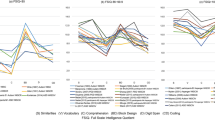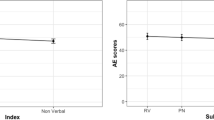Abstract
Asperger syndrome (AS) patients show heterogeneous intelligence profiles and the validity of short forms for estimating intelligence has rarely been studied in this population. We analyzed the validity of Wechsler Intelligence Scale (WIS) short forms for estimating full-scale intelligence quotient (FSIQ) and assessing intelligence profiles in 29 AS patients. Only the Information and Block Design dyad meets the study criteria. No statistically significant differences were found between dyad scores and FSIQ scores (t(28) = 1.757; p = 0.09). The dyad has a high correlation with FSIQ, good percentage of variance explained (R 2 = 0.591; p < 0.001), and high consistency with the FSIQ classification (χ 2(36) = 45.202; p = 0.14). Short forms with good predictive accuracy may not be accurate in clinical groups with atypical cognitive profiles such as AS patients.

Similar content being viewed by others
References
Allen, D. N., Huegel, S. G., Gurklis, J. A., Jr., Kelley, M. E., Barry, E. J., & van Kammen, D. P. (1997). Utility of WAIS-R short forms in schizophrenia. Schizophrenia Research, 26, 163–172.
American Psychiatric Association. (1994). Diagnostic and statistical manual of mental disorders (4th ed.). Washington, DC: APA.
Bennett, T., Szatmari, P., Bryson, S., Volden, J., Zwaigenbaum, L., Vaccarella, L., et al. (2008). Differentiating autism and Asperger syndrome on the basis of language delay or impairment. Journal of Autism and Developmental Disorders, 38, 616–625.
Blyler, C., Gold, J., Iannone, V., & Buchanan, R. (2000). Short form of the WAIS-III for use with patients with schizophrenia. Schizophrenia Research, 46, 209–215.
Bowler, D., Mathews, N., & Gardiner, J. (1997). Asperger’s syndrome and memory: Similarity to autism but not amnesia. Neuropsychologia, 35, 65–70.
Brooks, B., & Weaver, L. (2005). Concurrent validity of WAIS-III short forms in a geriatric sample with suspected dementia: Verbal, performance and full scale IQ scores. Archives of Clinical Neuropsychology, 20, 1043–1051.
Donders, J. (1992). Validity of two short forms of the WISC-R in children with traumatic brain injury. Journal of Clinical Psychology, 48, 364–370.
Donnell, A. J., Pliskin, N., Holdnack, J., Axelrod, B., & Randolph, C. (2007). Rapidly-administered short forms of the Wechsler adult intelligence scale-3rd edition. Archives of Clinical Neuropsychology, 22, 917–924.
Ehlers, S., Nydén, A., Gillberg, C., Sandberg, A., Dahlgren, S., Hjelmquist, E., et al. (1997). Asperger syndrome, autism and attention deficit disorders: A comparative study of cognitive profiles of 120 children. Journal of Child Psychology and Psychiatry and Allied Disciplines, 38, 207–217.
Finch, A. J., Kendall, P., Spirito, A., Entin, A., Montegomery, L., & Schwartz, D. (1979). Short form and factor-analytic studies of the WISC-R with behavior problem children. Journal of Abnormal Child Psychology, 7, 337–344.
Ghaziuddin, M., & Mountain-Kimchi, K. (2004). Defining the intellectual profile of Asperger syndrome: Comparison with high-functioning autism. Journal of Autism and Developmental Disorders, 34, 279–284.
Gillberg, C. (1995). The prevalence of autism and autism spectrum disorder. In F. C. Verhulst & H. M. Koot (Eds.), The epidemiology of child and adolescent psychopathology (pp. 227–257). Oxford: Oxford University Press.
Gillberg, C. (1998). Asperger syndrome and high-functioning autism. Review. British Journal of Psychiatry, 172, 200–209.
Gillberg, I. C., & Gillberg, C. (1989). Asperger syndrome—Some epidemiological considerations: A research note. Journal of Child Psychology and Psychiatry, 30, 631–638.
Haynes, J. (1982). Validity of a WISC-R short form with male delinquents. Journal of Clinical Psychology, 38, 406–408.
Haynes, J. P. (1983). Comparative validity of three Wechsler short forms for delinquents. Journal of Clinical Psychology, 39, 275–278.
Hollingshead, A. B., & Redlich, F. C. (1958). Social class and mental illness. New York: Wiley.
Hunter, J., Yule, W., Urbanowicz, M. A., & Lansdown, R. (1989). Cross-validation of short forms of the WISC-R in two British samples. British Journal of Educational Psychology, 59, 366–371.
Kaufman, A., Ishikuma, T., & Kaufman-Packer, J. (1991). Amazingly short forms of the WAIS-R. Journal of Psychoeducational Assessment, 9, 4–15.
Klin, A., Volkmar, F. R., Sparrow, S. S., Cicchetti, D. V., & Rourke, B. P. (1995). Validity and neuropsychological characterization of Asperger syndrome: Convergence with nonverbal learning disabilities syndrome. Journal of Child Psychology and Psychiatry, 36, 1127–1140.
Lange, R., & Iverson, G. (2008). Concurrent validity of Wechsler adult intelligence scales-third edition index score short forms in the Canadian standardization sample. Educational and Psychological Measurement, 68, 139–153.
Leckliter, I. N., & Matarazzo, J. D. (1989). The influence of age, education, IQ, gender, and alcohol abuse on Halstead–Reitan neuropsychological test battery performance. Journal of Clinical Psychology, 45, 484–512.
Lord, C., Rutter, M., Goode, S., Heemsbergen, J., Jordan, H., Mawhood, L., et al. (1989). Autism diagnostic observation schedule: A standardized observation of communicative and social behavior. Journal of Autism and Developmental Disorders, 19, 185–212.
Minshew, N. J., Goldstein, G., Muenz, L. R., & Payton, J. B. (1992). Neuropsychological functioning in nonmentally retarded autistic individuals. Journal of Clinical and Experimental Neuropsychology, 14, 749–761.
Minshew, N., Turner, C. A., & Goldstein, G. (2005). The application of short forms of the Wechsler intelligence scales in adults and children with high functioning autism. Journal of Autism and Developmental Disorders, 35(1), 45–52.
Missar, C. D., Gold, J. M., & Goldberg, T. E. (1994). WAIS-R short forms in chronic schizophrenia. Schizophrenia Research, 12, 247–250.
Ozonoff, S., Rogers, S. J., & Pennington, B. F. (1991). Asperger’s syndrome: Evidence of an empirical distinction from high-functioning autism. Journal of Child Psychology and Psychiatry, 32, 1107–1122.
Reitan, R. M. (1985). Relationships between measures of brain functions and general intelligence. Journal of Clinical Psychology, 41, 245–253.
Renner, P., Klinger, L., & Klinger, M. (2000). Implicit and explicit memory in autism: Is autism an amnesic disorder? Journal of Autism and Developmental Disorders, 30, 3–14.
Resnick, R. J., & Entin, A. D. (1971). Is an abbreviated form of the WISC valid for Afro-American children? Journal of Consulting and Clinical Psychology, 36(1), 97–99.
Reynolds, C., Wilson, V., & Clark, P. (1983). A four-subtest short form of the WAIS-R for clinical screening. Clinical Neuropsychology, 5, 111–116.
Rourke, B. (1989). Nonverbal learning disabilities: The syndrome and the model. New York: Guilford Press.
Rourke, B. T., & Tsatsanis, K. D. (2000). Nonverbal learning disabilities and Asperger syndrome. In A. Klin, F. R. Volkmar, & S. Sparrow (Eds.), Asperger syndrome. New York: Guilford Press.
Russel, J. (1997). Autism as an executive disorder. Oxford: Oxford University Press.
Ryan, J., López, S., & Werth, T. (1998). Administration time estimates for WAIS-III subtests, scales, and short forms in a clinical sample. Journal of Psychoeducational Assessment, 16, 315–323.
Satler, J. (2001). Assessment of children cognitive applications (4th ed.). San Diego State University: Publisher Inc.
Seisdedos, N., Corral, S., Cordero, A., de la Cruz, M. V., Hernández, M. V., & Pereña, J. (1999). Normas de interpretación. In S. A. TEA Ediciones (Ed.), WAIS-III Escala de Inteligencia de Wechsler para adultos-III. Madrid, Spain: Manual Técnico.
Shoop, L., Columbia, M., Herrman, T., Johnstone, B., Callahan, C., & Roudebush, I. (2001). Two abbreviated versions of Wechsler adult intelligence scale-III: Validation among person with traumatic brain injury. Rehabilitation Psychology, 46(3), 279–287.
Siegel, D., Minshew, N., & Goldstein, G. (1996). Weschler IQ profiles in diagnosis of high-functioning autism. Journal of Autism and Developmental Disorders, 26, 389–406.
Silverstein, A. (1982). Two- and four-subtest short forms of the Wechsler adult intelligence scale-revised. Journal of Consulting and Clinical Psychology, 50, 415–418.
Silverstein, A. B. (1990). Short forms of individual intelligence test. Psychological Assessment, 2, 3–11.
Spek, A. A., Scholte, E. M., & van Berckelaer-Onnes, I. A. (2008). Brief report: The use of WAIS-III in adults with HFA and Asperger syndrome. Journal of Autism and Developmental Disorders, 38, 782–787.
Spreend, O., & Strauss, E. (1998). Wechsler intelligence test. In a compendium of neuropsychological test: Administration, norms, and commentary. Oxford: Oxford University Press.
Szatmari, P. (2000). The classification of autism, Asperger’s syndrome, and pervasive developmental disorder. The Canadian Journal of Psychiatry/La Revue canadienne de psychiatrie, 45, 731–738.
Szatmari, P., Tuff, L., Allen, M., Finlayson, J., & Bartolucci, G. (1990). Asperger’s syndrome and autism: Neurocognitive aspects. Journal of the American Academy of Child and Adolescents Psychiatry, 29, 130–136.
Taub, G. E. (2001). A confirmatory analysis of the Wechsler adult intelligence scale-third edition: Is the verbal/performal discrepancy justified? Practical Assessment, Research and Evaluation, 7(22). Retrieved September 10, 2010, from http://www.PAREonline.net/getvn.asp?v=7&n=22.
Ulloa, R. E., Ortiz, S., Higuera, F., Nogales, I., Fresan, A., Apiquian, R., et al. (2006). Interrater reliability of the Spanish version of schedule for affective disorders and schizophrenia for school-age children-present and lifetime version (K-Sads-Pl). Actas Españolas de Psiquiatría, 34, 36–40.
Ward, L. C. (1990). Prediction of verbal, performance and full scale IQs from seven subtests of the WAIS-R. Journal of Clinical Psychology, 46, 436–440.
Wechsler, D. (1997). In TEA Ediciones (Ed.), WAIS-III Wechsler adult intelligence scale-third edition. Technical manual. San Antonio, TX: Psychological Corporation.
Weschler, D. (1974). WISC-R, Weschler intelligence scale for children-revised, New York.
Weschler, D. (1997). WAIS-III, Weschler adult intelligence scale-third edition. Administration and scoring manual, San Antonio, TX.
Wing, L. (1993). The definition and prevalence of autism: A review. European Child and Adolescent Psychiatry, 2, 61–74.
Acknowledgments
Supported in part by the Spanish Ministry of Science and Innovation, Instituto de Salud Carlos III, CIBERSAM, and grants: PI04/0457 and “Estudio longitudinal del estado oxidativo de dos trastornos del neurodesarrollo temprano: esquizofrenia y síndrome de Asperger” (Fundación Alicia Koplowitz).
Author information
Authors and Affiliations
Corresponding author
Rights and permissions
About this article
Cite this article
Merchán-Naranjo, J., Mayoral, M., Rapado-Castro, M. et al. Estimation of the Intelligence Quotient Using Wechsler Intelligence Scales in Children and Adolescents with Asperger Syndrome. J Autism Dev Disord 42, 116–122 (2012). https://doi.org/10.1007/s10803-011-1219-8
Published:
Issue Date:
DOI: https://doi.org/10.1007/s10803-011-1219-8




